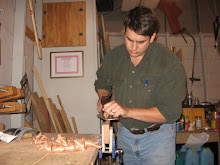This is a #7 Jointer plane I bought from a fellow when I ran the ad in the Market Bulletin about old planes. He had bought a lot of them at a school that was selling their old shop equipment. It is pretty rough looking, but it did not have much rust, and appeared not to have any pitting.

I bought this bench plane from him also. I am going to make a convex blade for it and make it a scrub plane. In theory, I could just swap a convex blade in and out of my bench plane when needed, but I have the feeling that I am going to have to open up the throat on it a little with a file to take the bigger shavings.

This is the bottom of the jointer. You can see waves in the sole perpendicular to the sides.

After lapping it on some 100 grit on a piece of float glass, you can really see the waves. I am not sure where these came from. They are pretty evenly spaced, so they must be milling marks left over from the original manufacture. If so, I can understand why people may have hated shop class.

I have lapped a number of blades and other things on my only sheet of wet/dry 100 grit. I'll need to pick up more. But, until then, I used a coarse DMT stone.

After quite some time, the sole is starting to look like this. There are a number of scratches in the sole. Additionally, a pit popped up right on the front of the throat. Also, on the leading side of the throat, there is a little dip. It it triangular shaped and can be seen in the picture. I am not sure how that got worn down. But there are few scratches in the sole too, so I figure this little fellow had a pretty rough life.

This photo was taken too close. But, this is the sole of the Stanley #4 I got off the clearance rack at the Woodcraft in Virginia. The sole came pretty flat. The photo was taken after I had done a bit of lapping on it. You can see how the corners and edges, especially on the leading edge, are starting to mill down. The darker gray are the milling marks leftover from the manufacturing process. These are quite deep.

Lots and lots of this will eventually produce a mirror finish sole.














































